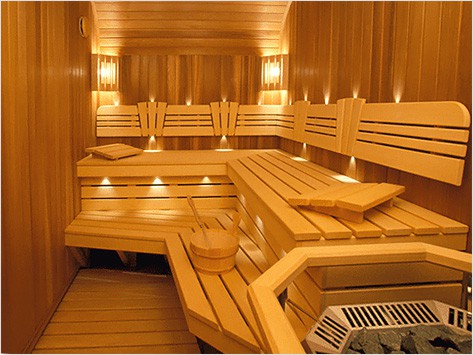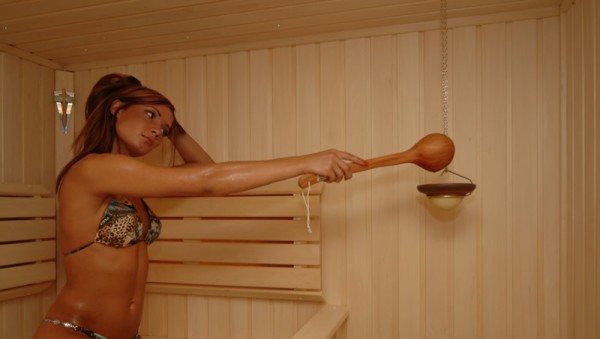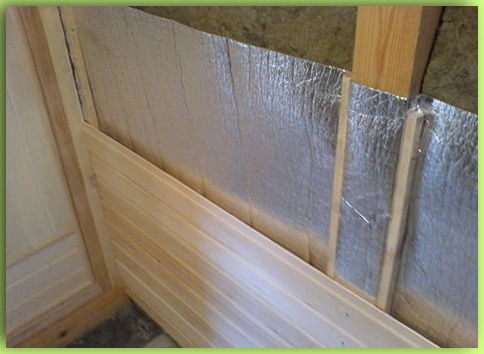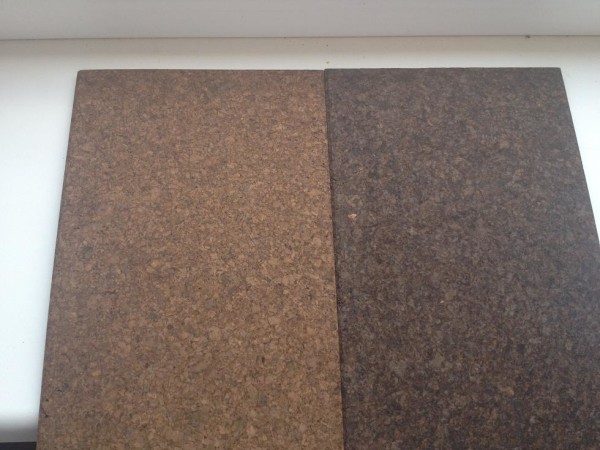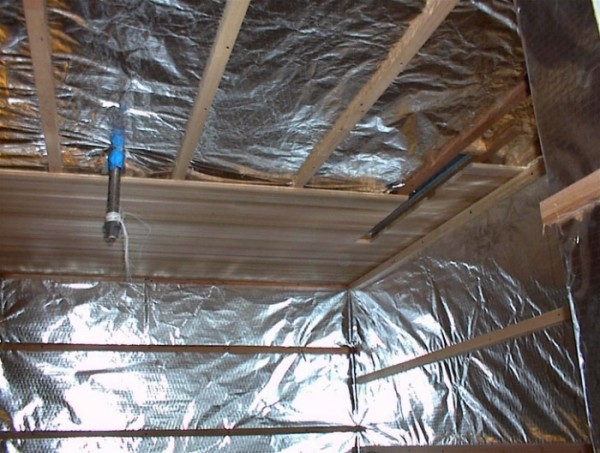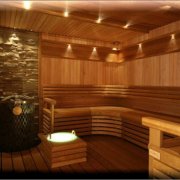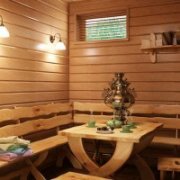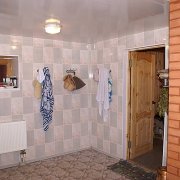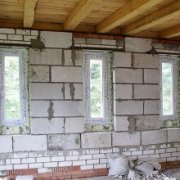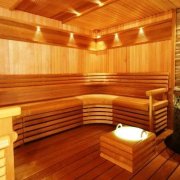Steam room finish: materials used
How to finish the steam room, this question is of interest to many owners of buildings. But it is better to solve it at the initial stage than to redo the already finished.
After all, facing surfaces is the key to success starting from design, which will attract the attention of visitors. And ending with heat transfer, which should be at its best.
The interior decoration of the steam room with your own hands will make the bathhouse more attractive and reliable, because when you do it yourself, you will not cheat and do all the work correctly.
The content of the article
Finish requirements
The selection of material should be approached with particular meticulousness, because when heated, it can and will be injured. When selecting, special attention should be paid to the heating parameter, this indicator should exceed 60 degrees.
Wood is best suited for decoration, but not only does it take part in the work, it is a whole complex of measures that should be done correctly.
Attention: There are some exceptions to the selection, for example, for the decoration of the stove, fireplace and the wall near them, mineral components are best suited. And of course it is desirable that they be natural.
So:
- When choosing a tree, pay attention that these are hardwoods. When choosing resinous ones, they heat up a resin after heating, which can be easily injured;
- It is not necessary to use the steam rooms inside and paintwork, which, when heated, can release substances harmful to health;
- To protect the panels, it is best to use special water-repellent agents, which are made on the basis of natural components. They will protect the surface. steam room finishes and will not be harmful to health;
- When facing, pay particular attention to waterproofing. It is it that affects strongly the preservation of heat and this is very important;
- When installing the facing material and using metal fasteners for fastening, you should lower the panels and hide the hats; you can also hurt them.
Bath Interior: Good to Know
There are some tips for interior decoration, and you should listen to them. Not always the desired materials may come up. They must meet certain requirements and parameters.
Wood
But let's get down to business.
First of all, it is necessary to understand that the process of building a bath is complex, long and scrupulous. There are many nuances.
Unfortunately, in one article it is simply impossible to answer all the questions, we will try to make out, in our opinion, the most important ones. The most important thing to understand is that it’s important to build not some kind of structure in which there is some kind of furnace that gives high temperature.
We are sure that the bath should bring not only pleasure, but first of all health, so let's look at the environmental issues of the bath.
It's no secret that the best baths are made from wood:
- Preference should be given to leaf species, it is best suited. Do not use conifers;
- Natural material, environmentally friendly without all kinds of impurities.
- The conversation is about natural wood, and not the currently widespread glued beam.
- Moreover, regardless of the shape of the material, whether it is a planed or rounded log, timber, the most important tree should be solid.
- Various glues are mandatory in the glued material.
- Under the influence of high temperatures, volatile chemicals are released from them.It is clear that there can be no talk of any health.
Thermal insulation
The most common question arises for those wishing to build do-it-yourself bath, this is what to insulate it with. After all, the bathhouse should store heat, giving it to its visitors without harm to the health of the latter.
We have already mentioned the "practical advice" of the "specialists", offering to insulate the bath with a variety of materials:
- Honestly, one can only be amazed at what they can advise an ignorant beginner.
- Typically, these tips begin with the use of polystyrene, mineral wool and ending with everything you can.
We want to declare responsibly: the absurdity of this situation is that almost all insulation materials offered by the modern construction market are not suitable for insulating a bathhouse.
No, of course, you can insulate the bathhouse with these materials, this is purely speaking from a technical point of view. The heat will remain in the bath, maybe even you will save on fuel, but most importantly, the use of these materials will lead to the fact that the bath will cease to be a bath in its full purpose.
As a result, instead of a useful bathing procedure, we get the illusion of such.
Thermal insulation materials - what can and cannot be done:
- The first thing that is important to know is that in any case, various foams should not be used to warm the bath. Neither white, packing polystyrene, nor any other.
- All of these materials are plastics. Any plastic after 60 degrees undergoes severe destruction.
Attention: Destruction: destruction of polymers under the influence of heat, light, oxygen. It leads to rapid aging of the material, its destruction and unsuitability for use for its intended purpose.
- In addition, during this process leading to the destruction of macromolecules, phenols are released.
Caution: Phenols are toxic, cause skin burns, and if inhaled, they can damage the human mucous membrane.
- It is also impossible to use extruded polystyrene foam.
What is unhealthy in the bath:
- Sometimes, "experts" offer to perform the warming of the bath using mineral wool.
- Their argument is quite simple, mineral wool is able to withstand temperatures of more than 1000 ° C.
- Since there is no such temperature in the bath, it means that it will serve faithfully for many years.
Yes, mineral wool will insulate your bath, withstand high temperatures, and will last for more than one year.
But how will this affect your health? We are building a bathhouse for health too.
Attention: You should know that the mineral wool also contains phenols, not so much as in polystyrenes, but also present.
But what happens to mineral wool when it “gives up” all phenols?
And the following will happen:
- Regardless of how carefully you have isolated the mineral wool from the bath room and the steam room in particular, small holes will inevitably remain.
- These are places from nails, self-tapping screws, and a lot more from what, just can’t keep track of everything.
- Through these openings, glass wool micro-dust will begin to penetrate into the bathhouse.
- Even mineral wool, covered at the factory with a foil specially designed for saunas, will not save, this is, to put it mildly, such a commercial move.
Attention: We repeat, if there is mineral wool, then there are phenols, and at high temperatures they are released. The loss of their mineral wool threatens the appearance of microscopic glass dust. No foil or anything else will save you from inhaling these microparticles. Talking about some kind of health and ecology in this situation is simply ridiculous.
The best insulation for a bath
But what if the constructed bath needs to be insulated? After all, there can be no material that can insulate a bath without harm to health.
Indeed, such material exists. Another thing is that it is now difficult to meet him on sale, although he had met and met quite often before, this is ordinary felt.
Attention: felt: natural natural material. It is obtained from animal hair by felting. Felt boots, just made of felt. The material is an excellent heat and sound insulator, environmentally friendly and safe.
Cork traffic jam. Another material that, unlike felt, is more commonly sold than a bathhouse can be insulated, is cork material.
You can use this material with the caveat:
- The fact is that in addition to natural cork material, there are many substitutes on sale with which it is not easy for a specialist to confuse this material.
- In addition, in our time, even real cork material is processed by chemical compounds. As a result, spoiled bath ecology.
As you can see, a wide selection of different insulation materials does not solve the whole problem of bath insulation.
This is most likely a national question:
- As a rule, many modern building materials are developed abroad.
- It was hardly planned to use them in the baths, therefore, the solution to the issue of warming the bath is actually not such a simple question as it might seem at first glance.
We repeat, unless of course you plan to build a bathhouse for your pleasure and health.
The foil is a vapor barrier. Another material that can be used without fear in warming a bath is foil. Rather, the foil is used not as a heater, but as a vapor insulator.
- It is very convenient to use it, just with felt.
- The fact is that the felt itself is a very hygroscopic material, and the use of foil is precisely its protection from getting wet.
- The bathhouse is Russian, it means there is a steam room, the finish in this case should take into account the presence of steam and moisture, respectively.
Foil is the main misconception.
Many are convinced that the foil has a heat-reflecting effect. This is true, but only if it is in open space.
But have you ever seen a bathhouse or sauna on the walls and ceiling of which is fixed in an open foil? This does not happen.
So:
- After the insulation and foil are installed, a coating of boards or lining is mounted on top of it.
- In this case, there can be no talk of any heat reflection: this is a myth.
- Understand correctly, heat reflection is when heat rays invisible to the eye are reflected off the surface.
- In this case, a board stands in the way of the foil, which absorbs them, due to which it heats up. Simple physics, nothing more.
Attention: The foil is attached not so to reflect the rays, its installation is mandatory, only this is done so that there is an obstacle to the penetration of moist air. The foil will not let him through.
Use plastic films in the bathhouse, we would not recommend you either. The reason in this case is one, the film is the same plastic.
Protective screen
In general, the decoration of steam rooms in our time has given rise to many myths and one of them is the device of a protective screen for stoves:
- In ancient times, bath stoves were built of brick.
- Brick is an excellent insulator of a room from exposure to heat rays.
- It warms up for a long time, but also for a long time gives off heat to the room. Heat is soft, healthy.
How do in our time:
- On sale there is a huge selection of different stoves made of metal. At first glance, it’s convenient, installed, fell asleep stones and use it.
- But you need to know that the metal almost does not absorb thermal rays, it quickly warms up, but also cools quickly. In other words, thermal rays do not linger in it.
- Who has been to saunas with such stoves more than once probably felt an unpleasant dryness with a smack of metal in his mouth.
- This is just the effect of thermal radiation.
- The heat in such a steam room is dry and unpleasant, we can safely say: for health, visiting such a bath is not good.
- In such furnaces, stones are on top and absorb rays only at the top.But this problem can be solved and the instruction in this case is as follows: to cover the entire furnace with a brick.
Another mistake.
But sometimes there are options when a brick screen is arranged so that the brickwork is staggered:
Attention: We responsibly declare that such a screen does not bring anything useful to your bathhouse. The only thing for which it serves is to protect the metal furnace from accidental contact with it.
- Through the holes in the chessboard, thermal radiation penetrates the room, dries the air and negates the usefulness of the procedures.
- In the photo below, just such a finish was made, the steam room in this case will be excessively dry and although it will heat up faster, the heat will pass faster without bringing anything useful.
Wood is a damper. What else is important to know?
Having a bath with an open log inside, or some other wood coating, we get another important advantage: smoothing out heat and water shock. The tree in this case is an excellent damper.
Imagine:
- Steam room finish
- Everything is insulated, vapor insulated and practically hermetic
- During the procedure, water is splashed on hot stones
- Instantly produces heat and therefore steam
- There is an increase not only in temperature, but also in the steam room pressure
- For the body, this is not entirely beneficial.
Attention: In this case, a freestanding log bath is the best compensator for these differences and does not affect health at all, all in moderation, all in favor. The brick structure, in this case, copes with this task worse.
In this article, we did not begin to consider in detail the methods of installation of certain elements of the bath. We did not thoroughly understand how to finish the steam room with our own hands.
You can read on the installation of each material on the pages of our site, there is given full instructions on how to do the work. But, nevertheless, we raised very important issues that allow you to make the right choice at the design and selection stage, which will allow you to avoid mistakes even before the start of construction, during which it is much more difficult and costly to correct them.
Now you know how to finish the steam room correctly and you can choose exactly the material that will best suit your requirements.
